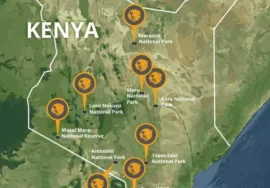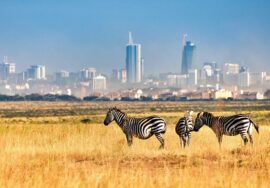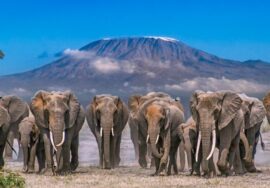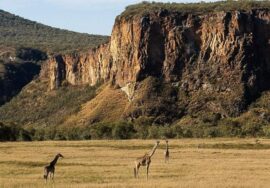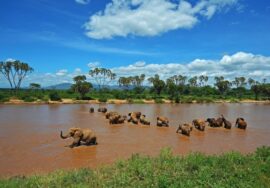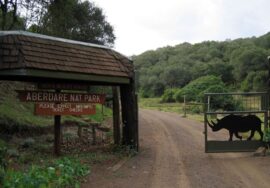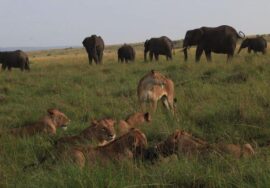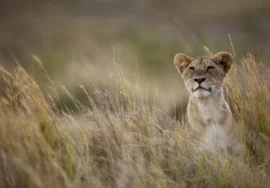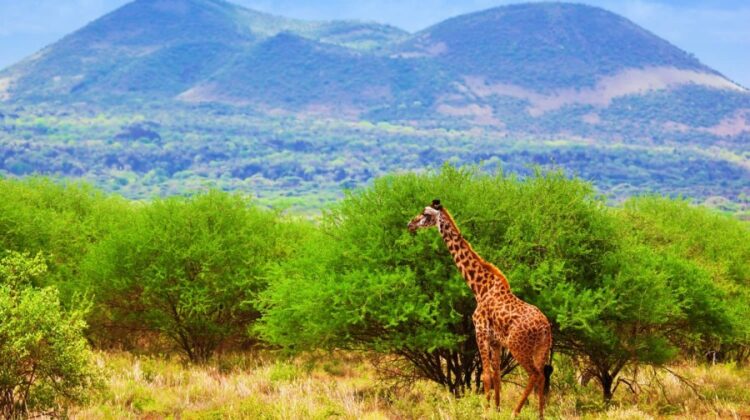
TSAVO WEST NATIONAL PARK
There are over 500 kinds of birds in this park, including African skimmers, yellow bishops, ostriches, starlings, weavers, kingfishers, and herons. They will make your safari more exciting. If you want to see amazing views, like Mt. Kilimanjaro covered in snow in the distance, don’t forget to climb to one of Tsavo’s many lookout points.
A leopard was seen in Tsavo West National Park. Kenya climbed a male rhino at the Kenya Sanctuary for Rhinos at Tsavo West.
The stately, shy rhino is an endangered species. They are hard to see in the wild, but not at Tsavo West, where they hide at the park’s Ngulia Sanctuary. Over 80 rhinos live safely in this 70 sq km (27 sq mi) area. The number of rhinos has been growing since the 1960s, when a lot of them were poached. In Kenya, this is one of the view points where people can see things.
The Mzima Springs
The ochres and browns of the harsh landscape are broken up by the rich, green colors of Mzima Springs. This oasis attracts the park’s thirsty animals and provides food and water for many of its own, including hippos, Nile crocodiles, fish, and migrating birds.
Elephants, gazelles, zebras, and giraffes come to the banks of the millions of gallons of clear water and palm trees that line the shores. Hike along the nature walks here and check out the unique pool where you can see hippos underwater.
Hippos
Visit Tsavo West National Park to see Volcanic Ridges and Lava Beds. Have you ever seen a lava flow that is 8 km (5 mi) long and 1.6 km (1 mi) wide? People in the area thought it was the devil coming out of the ground when the Shetani flow emerged 500 years ago.
A lot of volcanic objects can be found in Tsavo. Check out the Chaimu Crater, which means “Devil’s Crater” in the language of the Kamba people who live there. There is black lava rock all over this new volcano. You can also climb Kichwa Tembo or the Ivory Tower to get a better view of the park.
How to Get the Most Out of Tsavo West National Park
The Whirling Rocks – Still another place to climb and watch the wildlife and birds, like eagles flying in right at your eyes.
After miles of brush and dry grassland, Mzima Springs is a cool, lush sight. Every day, more than 200 million gallons of fresh water flow through these springs, feeding all kinds of animals, fish, and birds.
A Lot of Birds—Tsavo West is home to hundreds of different kinds of birds. Kingfishers, hornbills, ostriches, and herons can be found in the park’s green areas. But also keep an eye out for goshawks, skimmers, and other birds that migrate. Vultures also like to hang out in the trees nearby.
Lakes and lava flows: The Shetani lava flow is one of the biggest in Africa, but it’s only been going for a few hundred years. People thought that the red, fiery gas that came up from the ground was the devil coming out from below. Now it’s easy to walk through these fields and look at this volcanic treasure.
When is the best time to go?
The dry season, from June to September, is the best time to see wildlife because there are fewer plants and trees in the area, and animals are more likely to be near waterholes and streams.
For the most beautiful views of the park’s plants and birds, though, you should go on trek from October to May, when it rains a lot.
The business is open from 6 a.m. to 6 p.m.
How to get there: Safari Trips to Kenya can help you book a tour. It will be a style trip because the 4×4 safari Jeep is specially equipped for it.
You can get to the park by air from Chyulu, Mtito Andei, Tsavo, Jipe, and Ziwani, which are all close by.
By train: Get on the Madaraka Express, which is Kenya’s newest high-class train. We can take care of everything.

